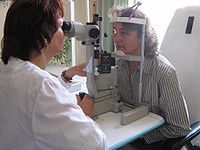
Photo from wikipedia
Purpose To compare changes in anterior segment parameters under light and dark (light-to-dark) conditions among eyes with chronic primary angle-closure glaucoma (CPACG), fellow eyes with confirmed or suspect primary angle-closure… Click to show full abstract
Purpose To compare changes in anterior segment parameters under light and dark (light-to-dark) conditions among eyes with chronic primary angle-closure glaucoma (CPACG), fellow eyes with confirmed or suspect primary angle-closure (PAC or PACS), and age-matched healthy eyes. Methods Consecutive patients with CPACG in one eye and PAC/PACS in the fellow eye, as well as age-matched healthy subjects were recruited. Anterior segment optical coherence tomography measurements were conducted under light and dark conditions, and anterior chamber, lens, and iris parameters compared. Demographic and biometric factors associated with light-to-dark change in iris area were analyzed by linear regression. Results Fifty-seven patients (mean age 59.6±8.9 years) and 30 normal subjects matched for age (60.6±9.3 years) and sex ratio were recruited. In regards to differences under light–to-dark conditions, angle opening distance at 500 μm (AOD500μm) and iris area during light-to-dark transition were smaller in CPACG eyes than fellow PACS/PAC eyes and normal eyes (P<0.017). Pupil diameter change was largest in normal eyes, and larger in PACS/PAC eyes than CPACG eyes (P<0.017). There was an average reduction of 0.145 mm2 in iris area for each millimeter of pupil diameter increase in CPACG eyes, 0.161 mm2 in fellow PAC/PACS eyes, and 0.165 mm2 in normal eyes. Larger iris curvature in the dark and diagnosis of PACG were significantly associated with less light-to-dark iris area changes. Conclusions Dynamic changes in iris parameters with light-to-dark transition differed significantly among CPACG eyes, fellow PAC/PACS eyes, and normal eyes. Greater iris curvature under dark conditions was correlated with reduced light-to-dark change in iris area and pupil diameter, which may contribute to disease progression.
Journal Title: PLoS ONE
Year Published: 2017
Link to full text (if available)
Share on Social Media: Sign Up to like & get
recommendations!